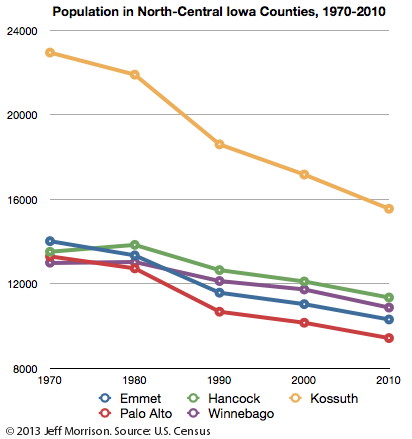
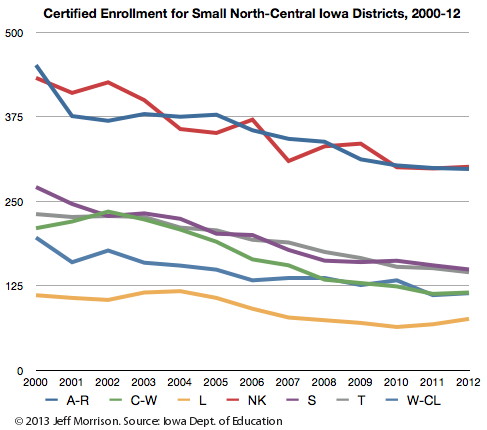
Kossuth County Area Schools and Rural Iowa's Population Collapse
Empty houses and stores and community
halls and even churches are signs of a fading past; empty schools are
signs of a fading future.
The New York Times, April 9, 2006
As you can see from the survey, over
90% of our community does not want to reorganize. Therefore
reorganization is not an issue. We can not discuss reorganization at
this time. The community is united in their opinion on this issue.
Titonka School Board letter to the editor, Titonka Topic, Oct. 6, 1994
20 years before Titonka Consolidated School District ceased to exist
Kossuth County is an accident of timing. The same sequence of legislative acts in the mid-19th century that made Humboldt County one row of townships shorter than it should be made Kossuth the largest county in Iowa and enshrined the number 99 in state history.
Kossuth, and its neighbors to the west and east, have held tenaciously to what have been among the smallest schools in Iowa in the modern era. From 1978 to 2010, there were only four complete mergers. But in the 2010s, that grip on local control is being upended in one of the most widespread and visible signs of Iowa's rural population decline.
Since it's the size of the counties on either side combined, you would expect Kossuth County to have about double the population, and it did 40 to 50 years ago. But that also meant that as Iowa's rural counties began to lose people by the carload, Kossuth's plunge would be twice as steep. Fewer adults in the area means fewer children in the area too, a cycle that is compounding.


These graphs show just how badly this part of northern Iowa is bleeding. The two counties to Kossuth's west, Emmet and Palo Alto, lost about 7,500 people between 1970 and 2010, slightly more than Kossuth alone. The five combined, though, have a drop equivalent to losing the entire city of Ottumwa.
During that time frame, the population distribution of Iowa notably shifted. In 1970, nine counties Black Hawk, Dubuque, Johnson, Linn, Polk, Pottawattamie, Scott, Story, and Woodbury held 40.4% of the state's population. In 2010, that percentage had jumped to 47.5%. Throw in Dallas County, which replaced Clinton in next place in the most recent census, and as of the 2011 census estimates, half of 3.05 million Iowans reside in 10 of 99 counties.

Iowa Highway 17 straddles the Kossuth-Hancock county line. Just visible to the east is Corwith. There are two ways into town: County Road B55, running along the section line, or old Iowa Highway 256. The latter was turned over as part of the Great Decommissioning of 1980, when many such short connectors were dropped from state control. Corwith is an hour from the nearest Wal-Mart.
Also visible from the road is the Corwith school. It is the quintessential three-story symmetrical brick building with additions behind it. For more than 30 of its 95 years of existence, it has served as the high school for two districts, Corwith-Wesley and LuVerne. The two were among the first, if not the first, to engage in grade-sharing after Iowa districts became K-12 in 1965. Despite the longevity, the two never combined. Like Woden-Crystal Lake and Titonka to the north, both even remained in separate Area Education Agencies, LuVerne in Area 3 and Corwith-Wesley in Area 2. Ironically, each AEA merged with others while the districts stayed the same. The schools could never merge because state law requires a combined certified enrollment of 300 students.
In the 2012-13 school year, LuVerne was officially the smallest school district in Iowa, with a certified enrollment of 76, and Corwith-Wesley the seventh-smallest, with a certified enrollment of 115. Unofficially, by actual head count, they're the 10th- and 11th- smallest. Number 1, Clearfield in southwest Iowa, began plans to dissolve in 2014. C-W and L, however, tried to take a different tack. Although C-W is equally split in area between Hancock and Kossuth counties, both boards voted in April 2013 to send junior high and high school students to Algona starting in 2015. But, since Corwith-Wesley's K-6 students were already going to LuVerne, the state asked how it could be a school district without any students. After that, there was no option but to dissolve.
To illustrate how small Corwith (pop. 309) is, look at the two 2011 pictures below. Both are at the same scale. The large complex under construction at right is the new Ankeny High School, Southview Middle School, and athletic fields. Corwith-Wesley-LuVerne High School is at the bottom center of the left picture.
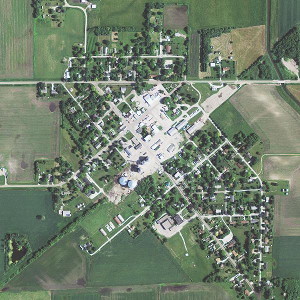
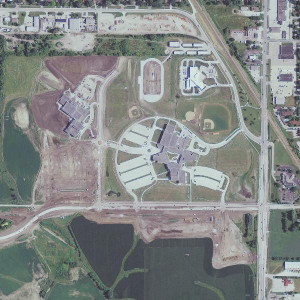
In the opposite corner of Kossuth County and into Emmet County, three school districts have been attempting to navigate a tripleheader consolidation process, which has only been achieved once since 1965. Armstrong-Ringsted played in four state 8-man football championships in a row in 2007-10, winning two. North Kossuth played in four state baseball tournaments in a row in 1995-98, winning two. That's not surprising since the district includes Bancroft, where private St. John High School racked up 15 state baseball appearances, eight of which were in the 11 years before its closing in 1989. Sentral has made it to state in both baseball and football since the turn of the century. Its school building is two miles east of Fenton.
The first things the districts started collaborating on were the athletic programs. North Kossuth and Sentral were first, playing as North Sentral Kossuth (since the combined teams made up the north-central part of Kossuth County, get it?) starting in 2007. Starting in spring 2011, A-R got into the act as well. All that, though, led to sentences like this one in the Emmetsburg News April 21, 2011: "The first meeting of two of the newest team affiliations in the Cornbelt Conference saw the golfers of Graettinger/Terril/Ruthven-Ayrshire fall in a pair of duals to North Sentral Kossuth/Armstrong-Ringsted Monday at Armstrong." For those of you keeping score at home, that's six towns and two areas for two teams, written out instead of made acronyms possibly because of their newness. Graettinger and Terril, in Emmet and Dickinson counties respectively, merged themselves in 2010 and have athletic sharing agreements with R-A to the south.
But, as these things so often do, the tripleheader-merger talks broke down when it was clear that buildings would have to close. In summer 2011, Sentral appeared to be the odd place out. "I do not know how for the long haul we can finance three buildings," North Kossuth school board president Jeannie Kinney said at one meeting. "My concern is for the long haul." Although North Kossuth and Sentral have been engaged in whole-grade sharing since the 2008-09 school year, and all three were sharing in 2012-13, it will be Armstrong-Ringsted and Sentral tying the knot first, with a consolidation effective in 2014.
Although the combined name would actually be pretty good NSKAR, pronounced "Nascar" the schools are going in a different direction. Starting in fall 2012, the sports teams, and school districts engaged in sharing, are called "North Union." This isn't to be confused with North Iowa, which is right beside it in northeastern Kossuth and western Winnebago counties; East Union, which is in Union County in southern Iowa; the town of West Union in northeast Iowa, which is where North Fayette High School is; or Union in La Porte City, which has presence in Benton, Black Hawk, and Tama counties.
For Woden-Crystal Lake and Titonka, all of the above is now academic. The districts parted ways in 2011, heading in opposite directions for county seats. Each district's last official year has zero K-12 students attending school in it. All the Woden-Crystal Lake students started going to Forest City in August 2012 even though the merger wouldn't take effect until July 1, 2013, and Titonka did the same thing one year later, sending all students to Algona in August 2013 with a merger July 1, 2014.
The below map shows what the school districts looked like before and may look like in the future. The color-paired sets were already engaged in sharing. North Iowa is shaded for clarity. As you can see, should current kernels of plans pan out, there could be two districts the size of Iowa counties in the near future. To further illustrate the wide open spaces involved, consider this: In 2012-13, the Kossuth County portions of Corwith-Wesley-LuVerne (green) had 124 students, Hancock County had 61, and the Humboldt County portion of LuVerne, the piece to the south, had six. Six.
Editor's note, 3/27/21: Parts of the predicted 2017 map did not happen. Lu Verne remains independent, with the absorption of most but not all of Corwith-Wesley, while North Union and North Kossuth have not officially consolidated. In the interest of keeping this piece otherwise intact, I am adding this disclaimer instead of deleting the image.
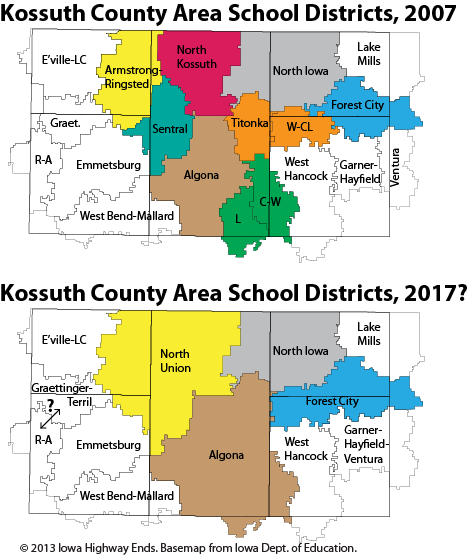
There is another factor in this sped-up consolidation trend besides the constant drop in population. In 2001, the Iowa Legislature passed a plan to phase out the state budget guarantee, which gave schools with declining enrollment the ability to receive an amount of money equal to the previous year. Those schools would receive less of that "guarantee" each year starting in fiscal 2003 (the 2002-03 school year) until it was gone in fiscal 2014 (the 2013-14 school year). Thus, as enrollments fell, especially in the tiniest districts, the financial hit was magnified.
And enrollment is falling like a stone or, since we're talking about multiple places, a rockslide. (See graphic at top.) That, combined with various mergers, has resulted in many towns losing school buildings since the turn of the century.
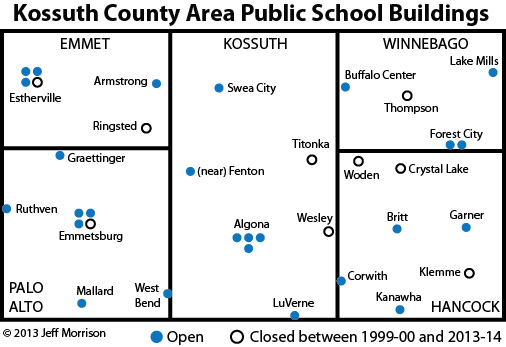
Starting with Belmond-Klemme closing the latter town's school in 2000, through Titonka's closure in the upcoming school year, it seems no place is safe. Even larger districts in the area have closed an elementary school. The status of both Corwith and LuVerne could change by the end of the decade.
Is there an end to all of this? If there is, it will be on the basis of geography and district size alone. There is nothing that indicates the trends of declining overall population and school enrollment will abate. What's happening to the school districts in and near Kossuth County is the most visible indication that holding on for dear life is becoming a less viable strategy in rural Iowa.
Page created 4/27/13, revised 6/10/14 and 3/27/21; picture of CWL High School taken 7/6/11
Sources